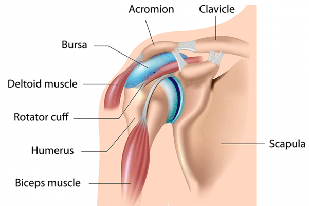
Bursitis most frequently occurs in the elbow, shoulder, hip, knee and heels.
Shoulder bursitis causing Shoulder Pain: Symptoms include tenderness at the outer shoulder, especially when raising the arm above the head, such as getting dressed. Applying pressure to the area can also cause pain. The subacromial bursa is the largest bursa in the body and susceptible to bursitis.
Elbow or olecranon bursitis causing Elbow Pain: Symptoms include swelling of the outer elbow and appears like a egg or golf ball is under the skin. These are often not painful unless infected and ROM (Range of Motion) is normal unless excessive swelling prevents normal movements.
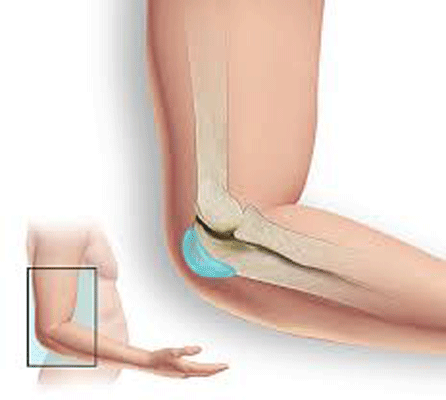
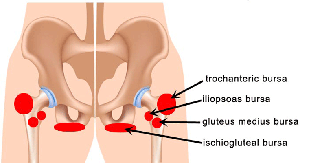
Retrocalcaneal (pain when standing on toes) and retroachilles bursitis can be common and cause pain and swelling at the back of the foot above the heel. This bursitis is often confused with Achilles tendon pain and Achilles tendonitis. Wearing proper shoes to prevent friction at the back of the heel area and supportive footwear can prevent occurrence. Some people have a “Haglund” deformity or prominent shape at the top of their heel which can cause irritation and bursitis. This pain (ache) and tenderness usually develop slowly. Pain can be exacerbated pointing or flexing the foot. Repetitive trauma to ankle by walking, jumping or running (especially uphill) which cause the foot to flex or recent increase in intensity to a workout without adequate stretching can increase retrocalcaneal bursitis. Other conditions such as Achilles tendon, OA, RA, gout and pseudo gout must be ruled out and treated.

Retrocalcaneal (pain when standing on toes) and retroachilles bursitis can be common and cause pain and swelling at the back of the foot above the heel. This bursitis is often confused with Achilles tendon pain and Achilles tendonitis. Wearing proper shoes to prevent friction at the back of the heel area and supportive footwear can prevent occurrence. Some people have a “Haglund” deformity or prominent shape at the top of their heel which can cause irritation and bursitis. This pain (ache) and tenderness usually develop slowly. Pain can be exacerbated pointing or flexing the foot. Repetitive trauma to ankle by walking, jumping or running (especially uphill) which cause the foot to flex or recent increase in intensity to a workout without adequate stretching can increase retrocalcaneal bursitis. Other conditions such as Achilles tendon, OA, RA, gout and pseudo gout must be ruled out and treated.
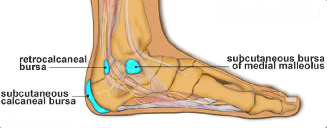
Gradually build up exercise routine and vary exercises to prevent overuse of a single joint. Strengthen and stretch the muscles around the joint. Avoid the activity causing the pain, ice the area, NSAIDS (ibuprofen, Aleve, Naprosyn), Compression to area (ace wrap) and elevate above your heart to improve swelling. Steroid injections are used to decrease inflammation directly at the site, Aspiration of the fluid can relieve pain from increased fluid. Treat the underlying cause of the bursitis. Physical Therapy can be helpful. Lift properly. Wear cushion pads at elbow and knees to prevent trauma. Low heeled cushioned shoes can help prevent bursitis of the foot. Take frequent breaks. Maintain a healthy weight. Always warm up and stretch before exercise or strenuous activities to protect joints from injury.
With all bursitis other causes must be ruled out such as: damage to tendons or muscles. Bone spurs or calcium deposits can cause irritation to surrounding tissue and cause bursitis. Low back problems like spinal stenosis, degenerative disc disease and hip osteoarthritis. Osteonecrosis, stress fracture, a tumor or infection can cause a bursitis. Certain medical conditions and medications can suppress some people’s immune systems and make them more susceptible to septic bursitis. Ex: those with cancer, HIV/AIDS, lupus, alcoholism, COPD, DM may be more likely to get septic
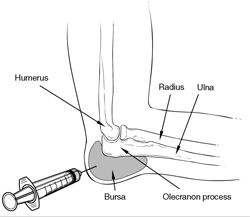
This information is for educational purposes only and is NOT intended to replace the care or advice given by your physician. Always seek the advice of your physician or other qualified health provider before starting any new treatment or with any questions you may have regarding a medical condition. For more information see our Medical Disclaimer.